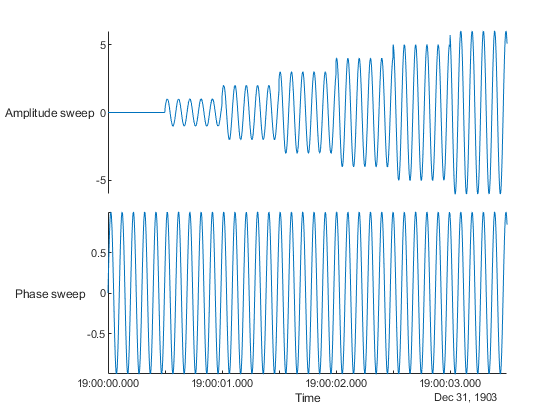Get Started Reading a TDMS File
This example shows how to read data from a TDMS file into MATLAB® for analysis.
The example TDMS file contains measurement data of a sine wave amplitude and phase. The measurements are in two channels, in the same channel group.
Inspect the TDMS File Contents
Use the tdmsinfo function to obtain channel group and channel names in the TDMS file.
fileName = "SineWave.tdms";
info = tdmsinfo(fileName);
info.ChannelListans=2×8 table
ChannelGroupNumber ChannelGroupName ChannelGroupDescription ChannelName ChannelDescription Unit DataType NumSamples
__________________ ________________ _______________________ _________________ __________________ ____ ________ __________
1 "Measured Data" "" "Amplitude sweep" "" "" "Double" 3500
1 "Measured Data" "" "Phase sweep" "" "" "Double" 3500
Read Data Properties from the TDMS File
Use the tdmsreadprop function to view data properties from the file.
tdmsreadprop(fileName)
ans=1×7 table
name description datetime author title datestring timestring
__________ ___________ _____________________________ _______ ___________________________ ____________ __________
"SineWave" "" 2022-01-13 10:03:31.000000000 "Admin" "Amplitude And Phase Sweep" "01/13/2022" "10:03:31"
Specify a ChannelGroupName and ChannelName arguments to view properties of a specific channel.
group = "Measured Data"; channel = "Amplitude sweep"; tdmsreadprop(fileName, ChannelGroupName=group, ChannelName=channel)
ans=1×19 table
name description unit_string datatype displaytype monotony NI_ChannelName NI_ExpIsRelativeTime NI_ExpStartTimeStamp NI_ExpTimeStamp NI_ExpXDimension novaluekey wf_increment wf_samples wf_start_offset wf_start_time wf_time_pref wf_xname wf_xunit_string
_________________ ___________ ___________ ___________ ___________ ________________ ______________ ____________________ _____________________________ _____________________________ ________________ ________________ ____________ __________ _______________ _____________________________ ____________ ________ _______________
"Amplitude sweep" "" "" "DT_DOUBLE" "Numeric" "not calculated" "Sine" 1 2022-01-13 08:38:35.674852848 2022-01-13 08:38:35.674852848 "t" "not calculated" 0.001 3500 0 1904-01-01 05:21:10.000000000 "relative" "Time" "s"
Read Timetable Data from the TDMS File into MATLAB
To read data into a timetable, derive the start time and time step, typically contained in the channel properties.
timeStep = tdmsreadprop(fileName, ChannelGroupName=group, ChannelName=channel, PropertyNames="wf_increment")timeStep=table
wf_increment
____________
0.001
startTime = tdmsreadprop(fileName, ChannelGroupName=group, ChannelName=channel, PropertyNames="wf_start_time")startTime=table
wf_start_time
_____________________________
1904-01-01 05:21:10.000000000
Using the start time and time step as arguments to the tdmsread function, read the data into MATLAB as a cell array of timetables. View some of the data from first channel group.
data = tdmsread(fileName, StartTime=startTime.wf_start_time, TimeStep=seconds(timeStep.wf_increment));
ttData = data{1};
head(ttData) Time Amplitude sweep Phase sweep
_____________________________ _______________ ___________
1904-01-01 05:21:10.000000000 0 0
1904-01-01 05:21:10.001000000 0 0.063418
1904-01-01 05:21:10.002000000 0 0.12658
1904-01-01 05:21:10.003000000 0 0.18923
1904-01-01 05:21:10.004000000 0 0.25112
1904-01-01 05:21:10.005000000 0 0.312
1904-01-01 05:21:10.006000000 0 0.37163
1904-01-01 05:21:10.007000000 0 0.42975
Use a stacked plot to visualize the relationship between the data of different channels.
stackedplot(ttData);
